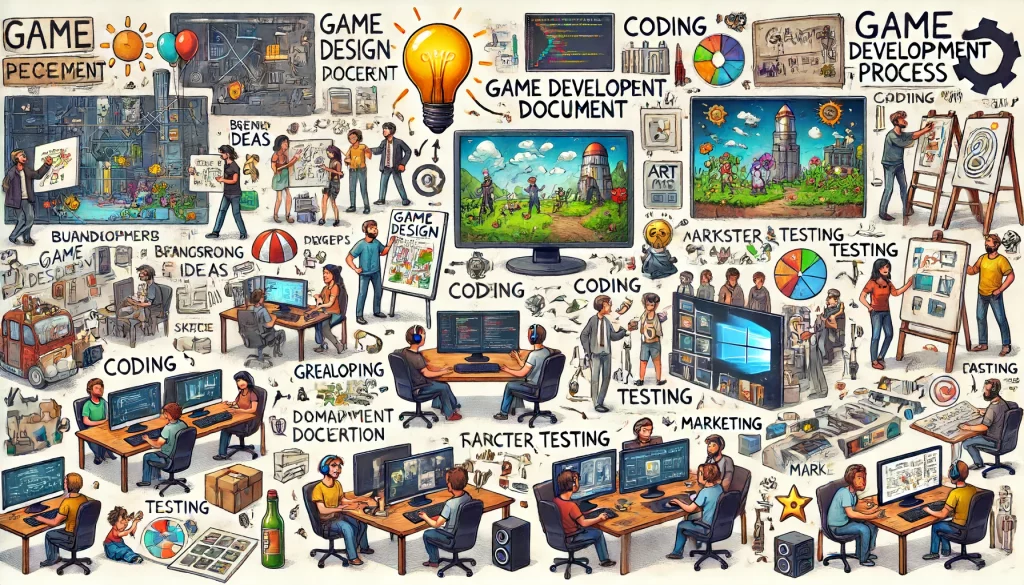The landscape of video game creation has undergone a significant transformation, expanding from modest endeavors by enthusiasts to grand ventures with teams of experts. Crafting a video game is a sophisticated endeavor, necessitating imaginative flair, technical prowess, and proficiency in project oversight.
1. Conceptualization and Structuring
Initial Idea and Ideation:
- Inspiration: The inception of a video game springs from an idea, possibly drawn from existing games, films, literature, or an original concept. Ideation sessions are crucial for expanding on the initial spark.
- Concept Outline: Draft a document outlining the fundamental idea, game type, intended audience, primary features, and distinct elements that will set the game apart.
Market Examination:
- Analysis of Peers: Investigate the market to discern the strengths and weaknesses of analogous games. Pinpoint what will make your game distinctive.
- Audience Insights: Delve into the preferences, habits, and profiles of your target demographic to ensure your game resonates with them.
Viability Assessment:
- Technical Viability: Evaluate the technical demands and constraints. Ascertain whether your team possesses the requisite capabilities and assets.
- Financial Viability: Calculate the monetary resources necessary for development, promotion, and distribution. Explore possible financial backers.
Game Design Documentation (GDD):
- Comprehensive Guide: The GDD is an exhaustive guide for the game’s creation, encompassing gameplay mechanics, narrative, characters, stages, user interface, and more.
- Evolving Document: The GDD is dynamic, continuously updated to reflect new insights and alterations.
2. Pre-Production Phase
Assembling the Crew:
- Foundational Team: Form a team comprising developers, artists, designers, writers, and other crucial roles. Clarify everyone’s duties.
- Collaborative Infrastructure: Implement tools and systems for project management, communication, and version control.
Prototyping Phase:
- Preliminary Builds: Develop early prototypes to evaluate gameplay and foundational elements. This aids in spotting issues and making adjustments.
- Iterative Feedback: Source feedback from the crew and a select group of evaluators to polish the prototype.
Project Strategy:
- Timelines and Incremental Goals: Segment the development into milestones and shorter sprints to monitor progress and ensure timely completion.
- Risk Strategy: Anticipate potential setbacks and devise strategies to mitigate them effectively.
3. Production Stage
Game Development Workflow:
- Coding: The development team programs the game, crafting logic, physics, AI behavior, and fundamental operations.
- Visual and Motion Creation: The artistic team develops the game’s visual components and animations, enriching the gaming experience.
Sound Design:
- Audio Crafting: Audio specialists craft sound effects, music, and voiceovers, vital for an immersive gaming environment.
Level Design and Development:
- Environmental Construction: Level designers shape the world, ensuring each stage is compelling and coherent with the game’s theme.
Narrative and Dialogue:
- Story Crafting: Writers elaborate the game’s story, characters, and conversations, enhancing the player’s engagement.
- Integration of Script: Seamlessly weave narrative elements into the gameplay.
4. Testing and Assurance of Quality
Alpha Testing Stage:
- Primary Evaluation: The alpha version, though playable, may have bugs and incomplete features. The focus is on rectifying major flaws.
- Team Insights: Collate feedback from the internal team and early testers to make necessary enhancements.
Beta Testing Phase:
- Expanded Testing: The beta stage brings in a broader group of evaluators to uncover previously unnoticed issues.
- Refinement: Act on beta feedback, rectify bugs, and fine-tune gameplay to deliver a stable and engaging experience.
Quality Assurance (QA):
- Thorough Examination: QA testers conduct comprehensive testing to pinpoint defects and performance issues.
- Issue Tracking: Employ a system to log and prioritize bugs, ensuring crucial fixes are made swiftly.
5. Final Preparations for Launch
Distribution and Platforms:
- Release Avenues: Choose platforms and channels for the game’s release, including digital stores and gaming consoles.
- Compliance: Verify that the game fulfills each platform’s certification standards.
Final Launch Day Prep:
- Server Capacity: If the game has online components, ensure servers can withstand expected traffic.
- Player Support: Establish channels to promptly address player concerns and issues.
6. Post-Release Activities
Observation and User Feedback:
- Community Engagement: Monitor player reactions and feedback for continuous improvement and demonstrate commitment to their experience.
- Content Expansion: Maintain player interest with regular updates, additional stages, characters, and features.
Grasping the intricate phases of video game development, from early brainstorming to post-launch support, enables developers to produce captivating and stand-out titles in a bustling market. Independent creators and large-scale teams alike should adhere to industry best practices and remain flexible to change, ensuring their vision comes to fruition and achieves acclaim in the realm of gaming.


